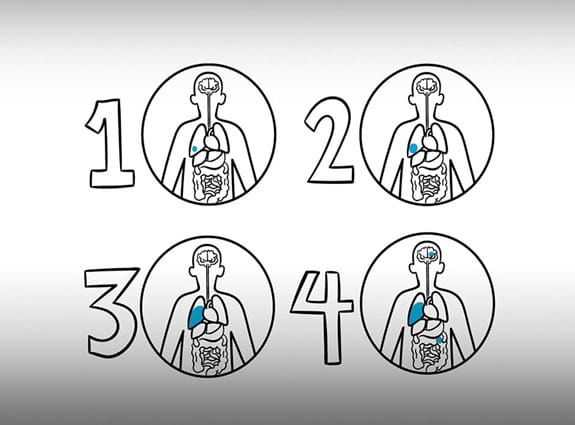What do cancer stage and cancer grade mean?
Narrator: When you have cancer, your doctors will find out as much as possible about the cancer to recommend the best treatment plan.
[Three doctors appear on screen. A woman in scrubs is pointing to an x-ray she is holding up for the others to see. A woman in a white coat with a stethoscope around her neck is looking at the x-ray. A man in a white coat is also looking at the x-ray. The scene ends.]
Narrator: This includes the cancer stage and grade.
[The doctor in the white coat appears sitting at a desk talking to someone with cancer. They are looking at different papers and images on the desk between them. The scene ends.]
Narrator: Cancer grade is based on how the cancer cells look.
[A doctor in a lab coat appears on screen. She is looking at a sample under a microscope.]
Narrator: Knowing the cancer grade helps your doctors predict how fast the cancer will grow and how likely it is to spread.
[We zoom in on a display showing what the doctor is seeing through the microscope. It is a simple drawing to represent a cancer cell. The focus then shifts to the drawing of the cancer cell and everything else on screen fades out. Other cancer cells appear from behind the single cancer cell, representing the growth and spread of cancer. The scene ends.]
Narrator: Grade is usually described using a number from 1 to 3 or 4.
[Numbers appear across the bottom of the screen. The number 1 is on the left, 2 is in the centre and 3 and 4 are together on the right.]
Narrator: The higher the number, the more different the cancer cells look from healthy cells and the faster they are growing.
[A single cancer cell appears above the number 1. A small group of cancer cells appears above the number 2. A larger group of cancer cells appears above 3 and 4. An arrow travels across the screen from left to right. As it goes across the screen, more cancer cells appear above each number. A couple of cancer cells appear above number 1. A small number of cancer cells appear above the number 2. The largest number of and most different-looking cancer cells appear above 3 and 4. The scene ends.]
Narrator: Cancer stage lets your doctors know how much cancer is in your body, where it is and how far it has spread. This helps them know what treatments to use.
[An outline of a human body appears on screen. It shows the brain, lungs, heart, liver, stomach, kidneys and intestines. A blue circle appears in a lung. As the narrator speaks, the circle gets bigger.]
Narrator: Cancer can spread within the organ that it started in, to nearby lymph nodes or to distant sites.
[Three small blue circles appear around the larger circle to show the cancer spreading within the lung. Then a small blue circle appears in the brain to show it spreading to distant sites. The scene ends.]
Narrator: To find out the stage, you may have different tests.
[An illustration of a chest x-ray appears on the left of the screen. Then a vial of blood appears in the middle of the screen. Finally, an illustration of a person in an MRI machine appears on the right. The scene ends.]
Narrator: Stage is described using a number from 1 to 4.
[At the top-left of the screen, the number 1 appears next to an outline of the body showing the brain, lungs, heart, liver, stomach, kidneys and intestines. Then the number 2 and the same outline of the body appears in the top-right of the screen. The number 3 and the outline of the body appear at the bottom left. Finally, the number 4 and the outline of the body appear at the bottom-right.]
Narrator: Stage 1 cancer is usually small and hasn't spread outside of where it started.
[The rest of the numbers and illustrations fade to focus on number 1 in the top-left of the screen. A small blue circle appears in the lung of the body.]
Narrator: The higher the number, the larger the tumour or the more it has spread. Stage 4 usually means it has spread to distant sites.
[As the narrator speaks, the focus shifts to the number 2 and the blue circle in the lung gets bigger. Then the number 3 is highlighted and most of the lung is blue. Finally, the number 4 is highlighted. Most of the lung is blue and blue circles appear in the brain and intestine.]
Narrator: How stage and grade are used to plan treatment is different for each type of cancer.
[All 4 illustrations fade back in. Then the scene ends.]
Narrator: Your doctor can tell you more about the stage and grade of your cancer and what this means for you.
[The doctor in the white coat appears sitting at a desk talking to someone with cancer. They are looking at different papers and images on the desk between them. The scene ends.]
Narrator: The Canadian Cancer Society is here to help. Visit cancer.ca or call us at 1-888-939-3333.
[The Canadian Cancer Society’s name, logo, phone number and website appear at the top of the screen. The Bank of Montreal (BMO) logo appears below as a proud sponsor of the video.]

